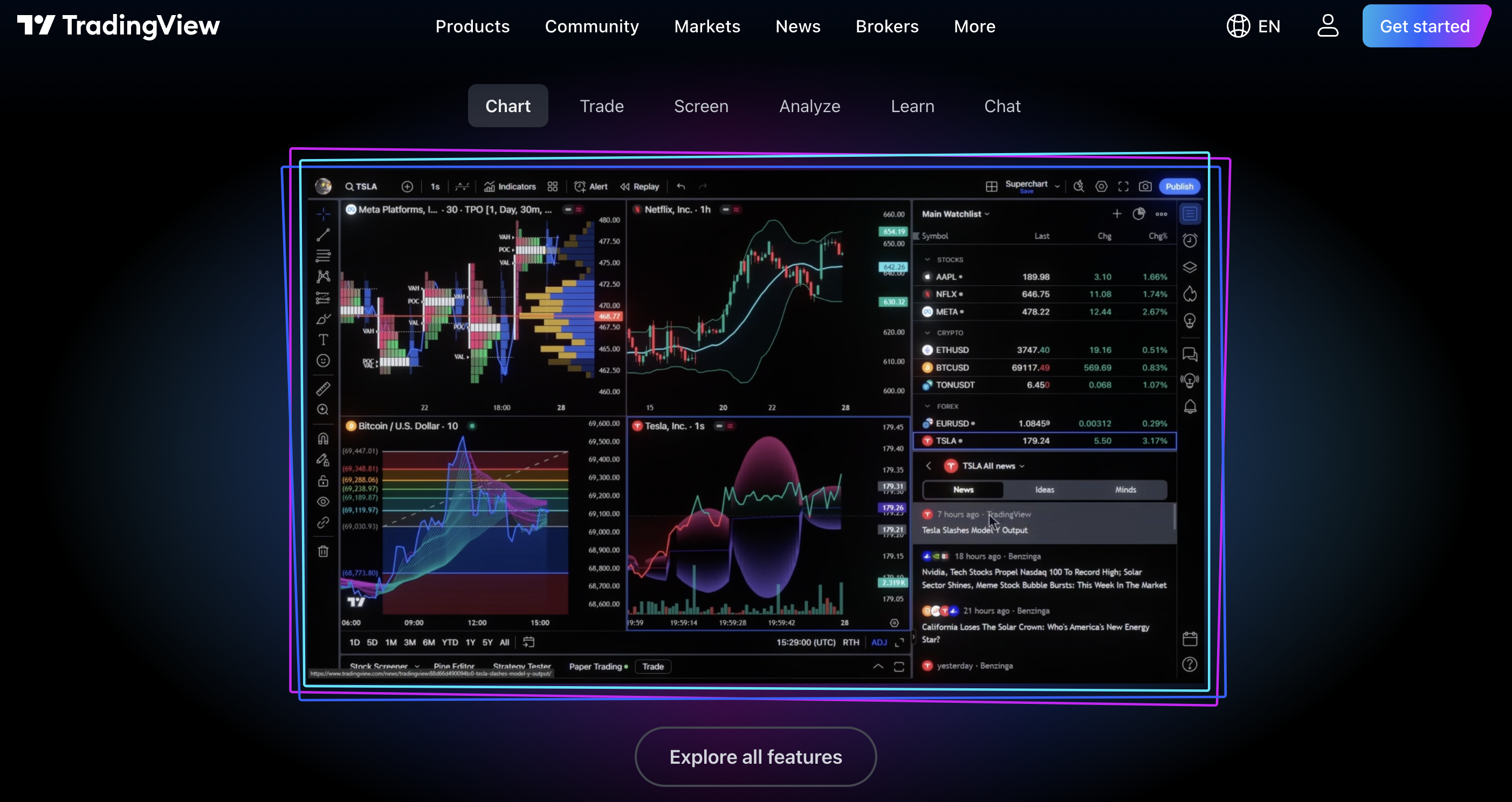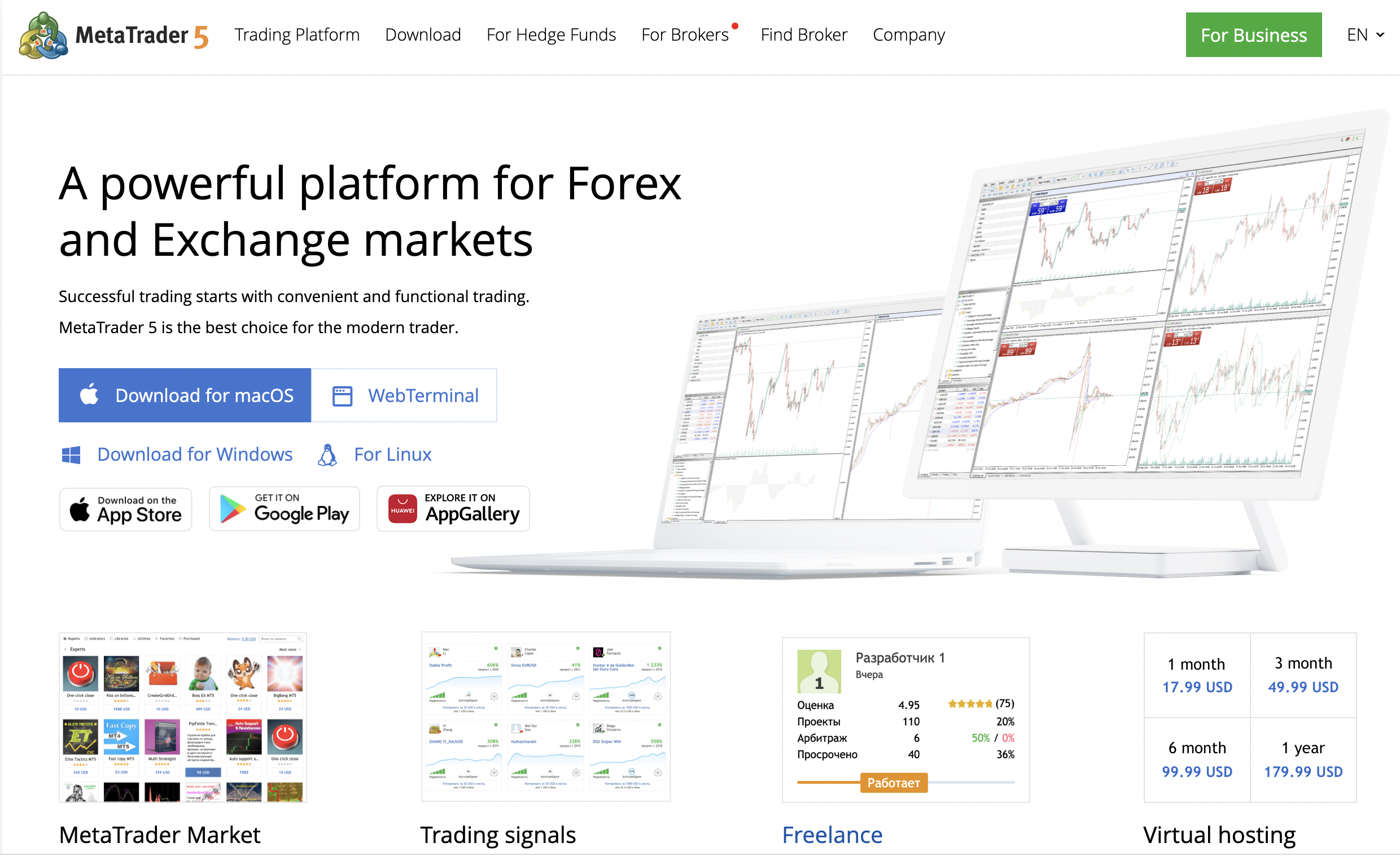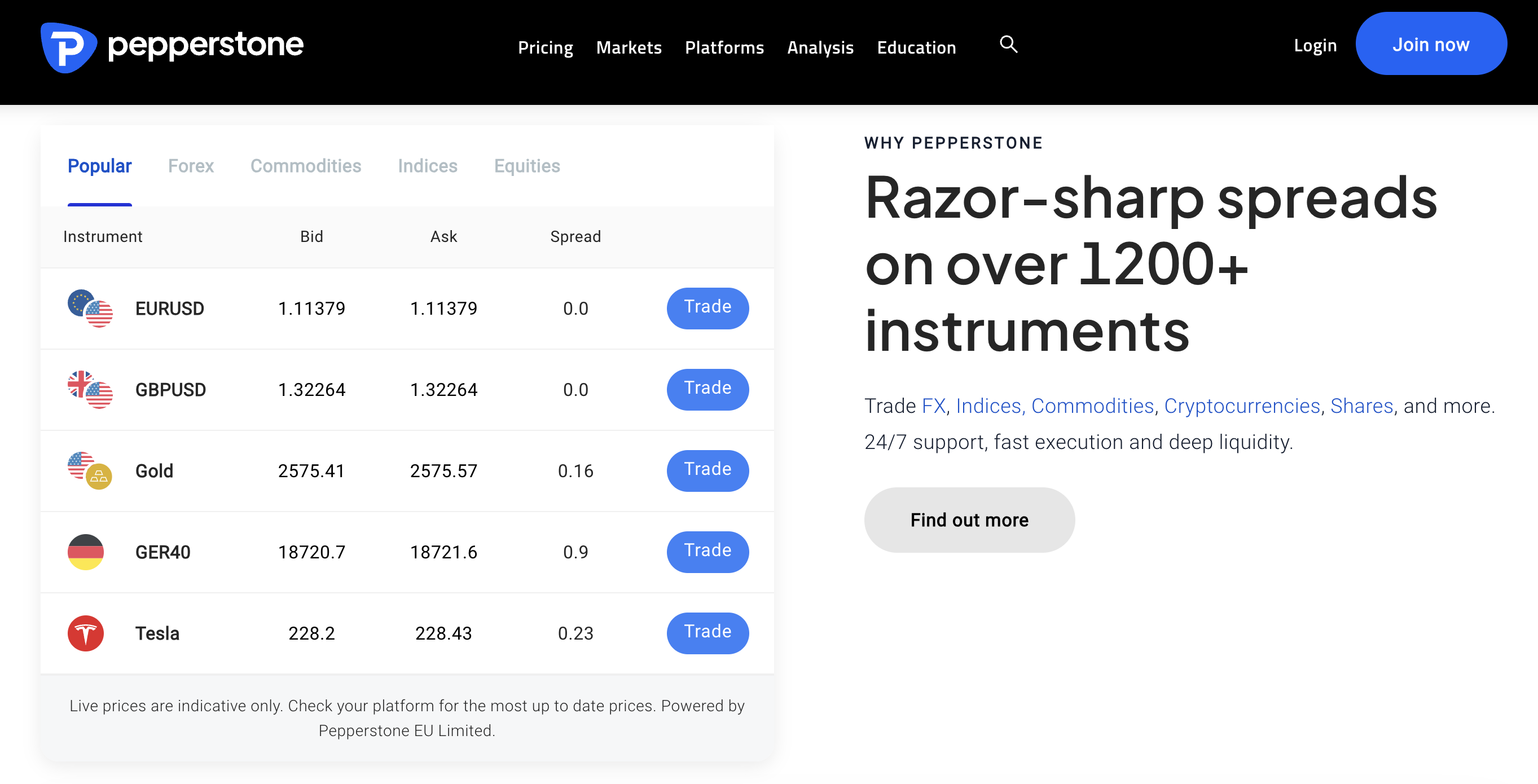Scalpers target small movements in the market, aiming to profit from an asset’s minute price fluctuations. Precision and speed are essential in scalping, as any delay can reduce profitability. In this guide, we explore the best tools to scalp trade in 2025.
We also discuss the essential charting software and technical indicators to optimize this strategy.
Let’s start with a quick overview of the top scalping trading platforms for 2025:List of the Best Scalp Trading Platforms for 2025:
Top Scalp Trading Platforms: In-depth Review and Analysis for 2025
Let’s explore the top 10 scalping trading platforms in more detail. Read on to choose the best platform for your scalping strategies.
1. Algobot – Automated Bot for Scalp Trading Multiple Assets
Algobot is a powerful trading bot that automates complex strategies like scalping. It’s programmed with AI to scan the market and spot the right trading opportunities. It also executes the trades and manages the risk – autonomously.
Put otherwise, you won’t need to manually find scalping opportunities. Instead, Algobot handles everything on the user’s behalf. It can be used for stocks, commodities, forex, indices, and crypto. It also trades multiple timeframes – crucial for scalp trading. Moreover, Algobot also has different risk levels to suit various trader profiles.

Algobot is also suitable for generating scalping signals. It sends the chosen asset, order type, and entry/exit prices via Telegram. Traders can then execute these positions manually. Algobot also supports demo mode – so it can be tested without risking real capital.
Algobot also offers exclusive indicators via TradingView. These are suitable for professionals to develop their own scalping strategies. To get started with Algobot, you can choose from three subscription packages, depending on the required features. These range from $50, $59.99, or $109.00 per month.
Pros:
Cons:
2. AvaTrade – Regulated Brokerage Platform With Integrated Social Trading
AvaTrade is a great choice for those seeking regulated scalp trading platforms. It operates under strict regulations in nine jurisdictions, ensuring security for traders. It supports a wide range of assets, including stocks, forex, ETFs, commodities, and crypto.
AvaTrade specializes in CFD instruments. Meaning, you can go long and short on assets – which can increase scalping opportunities. It also offers leverage of up to 30x – although this varies depending on the asset and jurisdiction. Additionally, you can test scalping strategies via the built-in demo account. What’s more, AvaTrade’s social trading platform lets you copy scalping strategies from experts.

AvaTrade integrates seamlessly with MT4 and MT5. It also has a native trading dashboard with advanced features. In terms of fees, AvaTrade doesn’t charge trading commissions. The spread is also competitive for most markets. Algobot also offers extensive educational materials and guides on trading strategies – including scalping.
Pros:
Cons:
3. ByBit – Scalp Trade Crypto With Up to 200x Leverage
If you’re planning to scalp crypto, then ByBit is worth considering. It boasts a matching engine that handles up to 100,000 transactions per second. This facilitates high-speed order execution, which is crucial for scalp trading. ByBit also features robust charting tools with multiple technical indicators.
Users can also implement trades with limit, market, conditional, and stop-loss orders. This allows scalpers to implement precise entry and exit strategies. Morever, ByBit features both spot and futures markets. Up to 200x leverage is available on some crypto trading pairs.

Bybit offers deep liquidity on major crypto pairs, reducing slippage for scalpers. Aside from these features, traders can automate their scalping strategies using ByBit bots. The fee structure is competitive, traders pay up to 0.10% for spot and 0.05% for derivatives. Moreover, high-volume traders are rewarded with discounted fees.
Pros:
Cons:
4. cTrader – Advanced Trading Platform With User-Generated Scalping Strategies
cTrader is known for its state-of-the-art trading tools. It provides highly customizable charts with timeframes down to 1 second. It also integrates dozens of indicators for scalpers relying on technical analysis. However, cTrader doesn’t execute trades – orders are processed through brokers integrating with its platform.
One standout feature of cTrader is cBots. These are automated strategies developed by other users. You will find a variety of cBots for scalping different asset classes. cTrader can also handle trades with leverage of up to 1000x (given that your chosen broker facilitates it). Additionally, cTrader has plugins and tools from third-party indicators.

cTrader can be downloaded to your preferred device or used as a web trading app. The interface is customizable, too. You can also invest in other users’ scalping strategies via the cTrader Copy platform. However, you’ll need to pay a performance and management fee of up to 30% and 10%, respectively.
Pros:
Cons:
5. TradingView – A Full-Fledged Trading Platform With Custom Indicators
TradingView is a must-have platform for scalpers at all levels. It’s packed with charting elements, live market data, and an assortment of technical analysis tools. There are over 100 built-in indicators, such as the RSI and MA. Additionally, there are thousands of custom indicators developed by other TradingView users.
TradingView’s Pine Script language allows you to develop bespoke strategies. Scalpers can leverage this to develop and backtest their unique trading algorithms. Its alert system is particularly useful for setting notifications for specific price levels or indicator conditions.

Like cTrader, TradingView doesn’t execute trades directly. But it connects to other brokers for order placement. Crucially, the majority of TradingView features are free. Nevertheless, it has paid plans starting at $14.95 for those who need further customization.
Pros:
Cons:
6. MT4 – Advanced Forex Trading Terminal With EA Integration
MT4 is widely regarded as the benchmark platform for forex trading. Its popularity stems from its rapid execution rates and low latency. Moreover, it offers real-time price quotes and supports various order types – allowing scalpers to enter and exit positions efficiently.
One of MT4’s key strengths is its customizable interface. Traders can set up multiple charts, timeframes, and technical indicators to suit their specific scalping needs. The platform supports nine timeframes, from 1-minute to monthly charts. MT4 also integrates with EAs to automate scalping strategies.

Additionally, scapers can deploy forex trading bots using the MQL4 programming language. MT4 also offers a strategy tester, allowing scalpers to backtest and optimize their trading plans using historical data. MT4 works with a wide range of brokers, thus extending its accessibility.
Pros:
Cons:
7. MT5 – Multi-Asset Trading Platform With 21 Timeframes
MT5 has improved on its predecessor, MT4. To begin with, this platform offers full support for stocks, forex, options, futures, and bonds. It also provides advanced charting capabilities with 21 timeframes, compared to MT4’s nine.
MT5 also offers a ‘Depth of Market’ feature – allowing scalpers to see the full order book. This presents a detailed market view for scalpers to make the right trading decisions. Furthermore, MT5 supports advanced algo trading with an improved scripting language.

Users can also backtest strategies without leaving the MT5 interface. As with MT4, MT5 is also widely supported by many scalping brokers. It can also be downloaded to both desktop and mobile devices. Best of all, it’s completely free.
Pros:
Cons:
7. Pepperstone – Leading Forex Trading Platform With 0 Pip Spreads
Pepperstone has gained popularity among scalp traders, particularly in the forex market. It has a highly competitive pricing structure and advanced trading conditions. The broker offers two main account types – Razor and Standard – catering to different trading styles.
For scalpers, the Razor account is especially attractive. It provides raw spreads starting from 0 pips – albeit with a $3.5 commission per traded lot. The low spreads allow traders to open and close positions with minimal cost. On the other hand, the Standard trading account has 0% commission but with variable spreads.

Retail traders are offered leverage of up to 30x, whereas professionals can get up to 500x. Pepperstone also offers deep liquidity – ensuring fast execution and minimal slippage. Aside from forex, Pepperstone also supports stock, indices, commodities, and crypto. It also integrates with TradingView, MT4/MT5, and even cTrader for advanced charting tools and indicators.
Pros:
Cons:
8. IC Markets – High-Speed Execution For CFD Scalp Trading
IC Markets also offers a favorable environment for CFD scalping. It supports forex, indices, stocks, commodities, bonds, and futures. Orders are placed at high speed with an average execution speed of under 66 milliseconds. This is particularly attractive for scalp trading.
In terms of trading terminals, IC Markets integrates with cTrader, MT4, and MT5. Meaning – users have access to robust drawing tools and indicators. IC Markets also offers a leverage of up to 30x for retail traders. Moreover, flexible position sizing is available for forex – allowing trades as small as 0.01 lots (10,000 units).

IC Markets feature raw spread accounts with spreads starting from 0.0 pips – but with up to $3.5 commission per traded lot. Alternatively, you can also choose a standard account with a variable spread and 0% commission.
Pros:
Cons:
10. Interactive Brokers – Advanced Trade WorkStation With Multiple Order Types
Last on our list is Interactive Brokers, a highly regulated trading platform. It supports a wide range of global markets and asset classes. Scalpers can diversify across stocks, forex, futures, and options. It also has a proprietary trading platform, Trader WorkStation (TWS), that provides advanced analysis tools.
This includes market scanners, live market data, third-party research, indicators, and charting tools. It also features dozens of order types to control your scalp trade positions accurately. You can also try the TWS demo platform before trading in live markets. The broker is also available via web and mobile apps – however, the features available vary widely.

Interactive Brokers offers two accounts – Lite and Pro. Lite users can trade US-based stocks and ETFs at 0% commission. Meanwhile, Pro users must pay $0.005 per share for a fixed commission structure. There’s also a tiered fee structure available – ranging from $0.0005 to $0.0035 per share. Interactive Brokers offers low spreads as narrow as 0.1 pip for forex.
Pros:
Cons:
What is a Scalp Trade and How Does it Work?
Scalping is a fast-paced trading style focused on an asset’s small price changes. Traders aim to buy and resell assets quickly to capitalize on minor price action. The key to successful scalping is executing numerous trades throughout the day, sometimes converting to hundreds of individual positions.
This way, the small profits from each trade assimilate over time to generate notable earnings. Crucially, scalping needs a disciplined exit strategy – because one large loss can wipe out multiple small gains. Traders must, therefore, act swiftly and consistently.
For instance, imagine that you are scalping a stock:
- Currently, a stock is priced at $100.
- You anticipate a small upward price movement; you buy 100 shares at $100 each.
- This brings your investment to $10,000.
- Within minutes, the stock price rises to $100.20.
- You quickly sell the shares for $100.20, gaining $0.20 per share.
- In this scalp trade, you profit $20 (100 shares x $0.20 per share).
Though the profit is small, repeating such trades multiple times a day can lead to attractive gains. The key here is speed – buying when the price dips slightly and selling as soon as a small profit is realized.
Top Scalp Trading Tools for Success
Scalping leans heavily on technical analysis. As such, you need robust and reliable tools for success. In this section, we look at the most important scalping trading tools.
Charting Tools
Charting tools display price movements and trading volumes visually. They help traders picture market data, identify trends, and make educated decisions quickly.
Here’s a comprehensive overview of how charting tools can be used effectively:
- Visualization of price data – Charts like candlesticks, bars, and lines offer different views of price data. Candlestick charts are perhaps the most used. They provide detailed insights into market sentiment with open, high, low, and close prices.
- Timeframes– For scalping, shorter timeframes like 1-minute or 5-minute are preferred. They capture quick price movements and execute trades based on rapid fluctuations in the market.
- Analyzing price patterns – Charts are also a great way to visualize live price data. They help identify various patterns and trends, such as head and shoulders, flags, or triangles. Recognizing these patterns helps traders predict future price action and modify their strategies accordingly.
- Price alerts – Most charting software notifies traders when an asset reaches a specific price. This way, you stay informed about potential trading opportunities without constant monitoring.
TradingView and MetaTrader 4/5 are some of today’s most popular charting software.
Technical Indicators
Charting tools and technical indicators go hand in hand. Indicators can be overlaid on charts to assess when to open and close scalping positions.
Below, we discuss some of the most common indicators used in a scalp trade.
Bollinger Bands
Bollinger Bands focus on the relationship between prices and volatility. This makes it a crucial indicator for scalping. It has three bands, which contract when the market is less volatile. On the contrary, the space between the band widens during high volatility.
- If an asset’s price touches or moves past the upper band, it’s potentially considered overbought. When this happens, the scalper might use it as a sign to open a short position.
- Conversely, the asset’s price dropping below the lower band can indicate an oversold condition. This signals the scalper to go long as the price could bounce back.
When scalping, traders use a 1-minute or 5-minute time frame for Bollinger Bands.
Stochastic Oscillator
The Stochastic Oscillator helps identify overbought and oversold conditions in the market. In simple terms, this indicator compares the current price of an asset to its trading range over a set period. This way, it can predict potential turning points.

The Stochastic Oscillator consists of two lines – the %K (black) and the %D (red dotted). There are also two key levels, 20 and 80, which are used as thresholds. Scalpers watch for crossovers between these two lines to time their entries and exits effectively.
- When the %K line crosses above the %D line from below the 20 level, it signals that the asset is oversold.
- A scalper would enter a long position at the crossover point and exit when the oscillator reaches above the 80 level, indicating that the asset is overbought. This technique works well when the market is consistently moving higher.
Similarly, in a bearish market, the strategy would be reversed.
- Scalpers look for bearish crossovers, where the %K line crosses below the %D line after reaching the overbought zone above 80.
- This signals that the asset may be about to decline, making it an ideal point to enter a short position.
- The trade is exited when the stochastic reaches below 20 or when a bullish crossover appears.
With the Stochastic Oscillator, scalpers can time their entry and exit based on the crossovers.
Simple Moving Average (SMA)
The SMA helps traders define trends by averaging an asset’s price over a specific period. In simple terms, it smoothens the short-term price deviations. This helps traders find the bigger picture of whether the asset is in an uptrend or not.
For scalping, traders commonly use a combination of two SMAs. For instance:
- The first would be a short-period SMA, like 5 or 9 days
- The second would be a long-period SMA, such as 20 or 50-days
- When the shorter SMA line crosses above the longer one – a buy signal is generated
- Conversely, when the shorter SMA moves below the longer one, a short-selling opportunity is indicated
Short SMAs offer an immediate reflection of recent price action. This is suitable for scalpers to spot opportunities early and take advantage of even small price shifts.
Parabolic SAR
The Parabolic SAR is a trend-following indicator. It’s used to identify potential reversal points and confirm the market direction. It appears as a series of dots above or below the price chart. The dots below the price indicate an uptrend. And above the price signals a downtrend.
Suppose a scalper is trading the EUR/USD forex pair.
- We’ll say that the Parabolic SAR dots are consistently below the price, signaling an uptrend.
- The scalper might enter a buy position, expecting the uptrend to continue.
- If the dots move above the price, it could signal a potential reversal.
- This would prompt the scalper to close the buy position. Or enter a sell position.
By reacting to these signals quickly, scalpers can leverage short-term price fluctuations.
Trade Simulators
Scalp trading tools can help you craft the right scalping strategy. However, you should also engage in testing before risking real capital. This is where trade simulators come in. You can use demo accounts offered by most trading platforms for this purpose.

Most demo accounts come with a certain amount of paper money you can use for trading. They simulate real market conditions and let you place trades accordingly. Demo trading also lets you assess how efficient your scalping strategy is. It also points out the flaws so you can improve.
Risk Management Tools for Scalp Trading
As with all trading strategies, scalping isn’t risk-free, meaning losses are possible. Hence, you need effective risk management tools to protect your capital.
Risk-Reward Ratio
The risk-reward ratio helps you compare a trade’s potential profit and loss. This is often paired with stop-loss and take-profit orders to ensure disciplined trading.
- A take-profit order ensures you exit a trade once your target profit is achieved.
- A stop-loss order caps your potential losses and prevents a small mistake from becoming significant.
For instance, let’s say you’ve a risk-reward ratio of 1:3. Meaning, for every $1 you risk, you’re aiming to gain $3. If you’re trading Bitcoin and buying at $50,000, you might set a stop-loss order at $49,500. And a take-profit order at $51,500. This means you’re seeking a price gain of $1,500. And a maximum decline of $500.
Position Sizing
Position sizing is paramount for controlling risk, especially when placing many trades in scalping. One effective approach in scalp trade is setting a fixed percentage you’re willing to risk for a trade. Typically, traders go for 1-2% when scalping.
To calculate the position size, first determine your entry and stop-loss limits. The difference between these points defines your risk per trade.
For instance:
- Suppose you enter a trade with a stop-loss set at $5 below your entry price.
- You then decide how many shares to buy based on how much total risk you are comfortable with.
- If you’re willing to invest $200 on this trade and the stop-loss risk is $5 per share, you would buy 40 shares ($200/$5 per share equals 40 shares).
Position sizes are usually modest since scalping trades are small and frequent. Smaller position sizes help manage risk effectively and prevent the accumulation of substantial losses.
Leverage Control
Leverage allows traders to enter a larger position with less capital. It’s essentially borrowing funds from a broker to increase your trade size. For example, with 10x leverage, a $1,000 position is amplified to $10,000.
Leverage enables scalpers to maximize their potential returns from each trade without needing much upfront capital. While leverage heightens potential gains, it also increases risk. With higher leverage, smaller position sizes are safer. Adjust your trade size to fit your risk limits, keeping potential losses manageable.
Automation and Scalping Bots: Should You Use Them?
Scalp trading is complex and time-consuming. You must use advanced tools to find scalping opportunities and be quick enough to capture them. Needless to say, the process can be highly demanding. However, today, you can automate the strategy using trading bots.

Today, the best trading bots can be programmed to execute scalp trades autonomously. They analyze market conditions, spot scalping possibilities, and run trades – all without human intervention. This eliminates the need to place each scalp trade manually.
Here’s why you might opt for automated trading bots when deploying a scalp trade system:
- Speed and Precision – Bots can execute trades at lightning speed. This reduces latency and takes advantage of small price changes without human error.
- 24/7 Monitoring – Bots can operate continuously, identifying and capitalizing on opportunities even when traders are offline. This is particularly useful for the crypto markets, which operate 24/7.
- Emotion-Free Trading – Bots follow pre-set strategies. This removes the influence of emotions, which often leads to flawed trades.
- Multitasking – Bots can scalp trade multiple assets simultaneously, enhancing diversification.
- Backtesting – Your bot strategy can be backtested using historical data for optimization.
AlgoBot is a great option for scalping multiple assets. After three years of backtesting, it has a win rate of over 81%. Whether you want to scalp stocks, forex, crypto, or commodities, Algobot automates the process.
Here are some of the best ways to optimize your scalp trade strategy: Scalping is a strategy that thrives on discipline. Therefore, stick to your trading plan and avoid emotional decisions. It’s also imperative to keep track of your trades to understand where the strategy could be improved.Key Tips for Optimizing Scalp Trading Strategies
Conclusion: Scalp Trade Success
In a nutshell, the right tools are imperative for successful scalp trading. This includes advanced charting tools, technical indicators, and effective risk management. Additionally, you should also have a reliable trading platform with a competitive fee structure.
Crucially, trading bots can streamline the scalping process. Algobot is a powerful AI bot that handles multiple assets. It also supports multiple short timeframes, ensuring it’s ideal for scalping. Users simply need to set their risk level; Algobot then provides a fully passive and tailored scalping experience.
FAQs
Can you make money with scalp trade?
Yes, a scalp trade can be profitable if executed correctly. However, success depends on effective strategies, fast execution, and disciplined risk management.
What are the best scalp trade tools?
Scalpers use advanced charting tools and technical indicators. Successful scalping also demands a broker that can execute high-speed trading orders.
What is the best scalping trade platform?
MetaTrader 5 (MT5), cTrader, and TradingView are popular choices for scalping due to their fast execution speeds. They also provide comprehensive technical analysis tools, customizable charts, and scalping strategy builders.
Can scalping be automated?
Yes, scalping can be automated using trading bots or EAs. These execute a scalping strategy based on preset conditions.
Which time frame is best for scalping?
Scalpers most commonly use the 1-minute and 5-minute timeframes. These short intervals allow traders to spot rapid market shifts and act accordingly.







